Chapter 19 - Light
The Electromagnetic Spectrum
Electromagnetic radiation can be described in terms of a stream of photons. Each photon is traveling in a wave-like pattern, moving at the speed of light and carrying some amount of energy
The only difference amongst radio waves, visible light, and gamma-rays is the amount of energy of the photons
Radio waves have photons with low energies
Microwaves have a little more energy than radio waves
Infrared still has more energy
Visible, ultraviolet, X-rays, and gamma-rays have photon energies that gradually increase respectively to each other
Gamma and Cosmic rays have the highest energy waves
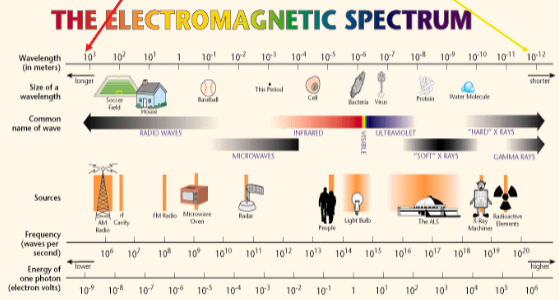

Radio Waves
Emitted by:
Astronomical objects
Radio station transmitters
Detected by:
Ground based radio telescopes
When radio is turned on, it will convert the radio wave energy into sound energy
Microwaves
Emitted by:
Gas clouds collapsing into stars
Microwave ovens
Radar stations
Cell phones
Detected by:
Microwave telescopes
Food (heated)
Cell phones
Radar (systems)
Infrared
Emitted by:
Sun and stars (near)
TV remote controls
Food warming lights (thermal)
Everything at room temperature or above
Detected by:
Infrared cameras
TVs, VCRs
Your skin
Visible
Emitted by:
The sun and other astronomical objects
Laser pointers
Light bulbs
Detected by:
Cameras
Human eyes
Plants (red light0
Telescopes
Ultraviolet
Emitted by:
Tanning booths (A)
The sun (A)
Black light bulbs (B)
UV lamps
Detected by:
Space based UV detectors
UV cameras
Flying insects (flies)
X-ray
Emitted by:
Astronomical objects
X-ray machines
CAT scan machines
Older televisions
Radioactive minerals
Airport luggage scanners
Detected by:
Space based X-ray detectors
X-ray film
CCD detectors
Gamma Rays
Emitted by:
Black holes
Active galaxies
Pulsars
Diffuse emission
Supernova
Gamma-ray bursts
Many other unidentified
Cosmic Rays
Cosmic rays come from deep space and can pass through the Earth
MOST DEADLY!
The Speed of Light
Light travels as a wave at a speed of 186,000 miles per second
The speed of light is:
c=3.0×10^8m/s
Light waves travel faster than sound waves!
In one second, a beam of light could travel around the Earth 7.5 times
The distance light travels in one year is called a light year
Closest star is about 4 light years away. In other words, if you sent a beam of light to that star, it would take about 4 years to get there
It takes the sun about 7.5 minutes for light to reach the Earth
We are technically looking back in time when we look at the stars!
Light is a transverse wave, and this can be proven with polarized lenses
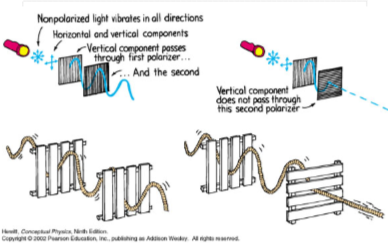
If light travels through an object, is is transparent
If some light passes through but not all and a light shadow is present, it is translucent
If light is blocked by an object and a dark shadow is cast, it is opaque
Colors

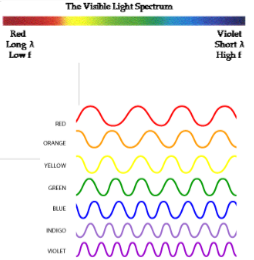
The color an object appears at depends on the colors of light that it reflects
The primary colors of light are red, green, and blue
White light can be split up to make separate colors

The separation of light into colors arranged according to their frequency, by interaction with a prism or diffraction grating
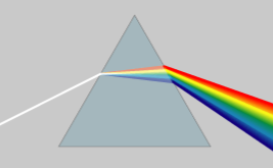
Refraction
When light travels from one medium to another different medium, it changes speed
The more dense it is, the slower it travels
Because of this change in speed, the light ray will also change its direction or bend
The bending of light as it travels from one medium to another is called refraction
Refraction can be explained in terms of the wave model of light, not the particle model
The speed of light in a vacuum or for calculations, air is c (3.0×10^8m/s)
Inside of other mediums, such as air, glass or water, the speed of light is different and less than c
The Law of Refraction
The index of refraction for a substance is the ratio of the speed of light in a vacuum to the speed of light in that substance

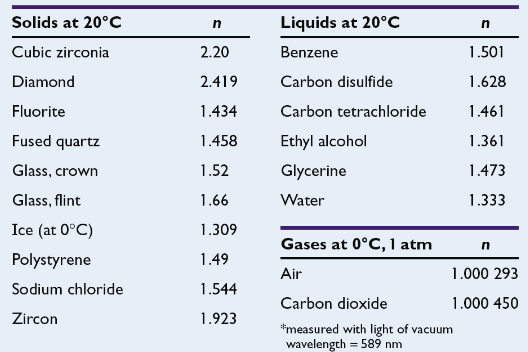
When light passes from a medium with a smaller index of refraction to one with a larger index of refraction (like from air to glass), the ray bends toward the normal
When light passes from a medium with a larger index of refraction to one with a smaller index of refraction (like from glass to air), the ray bends away from the normal
If n1<n2, then θ1>θ2
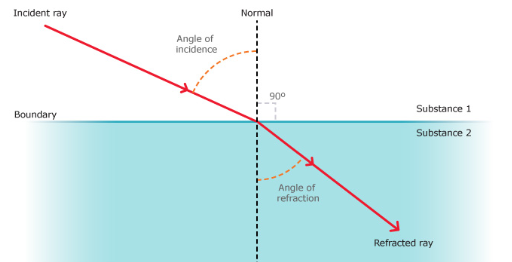

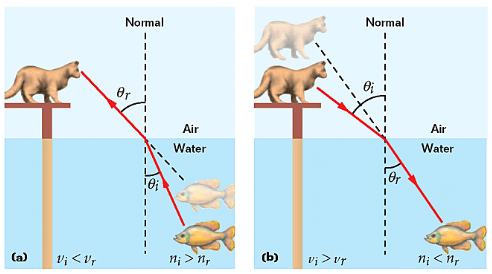
Objects can appear to be in different positions due to refraction
Snell’s Law determines the angle of refraction

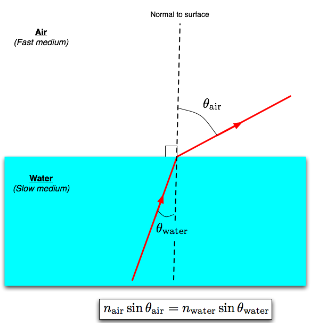
Sample Problem
A light ray of wavelength 589 nm (produced by a sodium lamp) traveling through air strikes a smooth, flat slab or crown glass at an angle of 30.0° to the normal. Find the angle of refraction of θr
nisinθi=nrsinθr
θr=sin-1[ni/nr(sinθr)]
θr=sin-1[1.00/1.52(sin30.0°)]
θr=19.2°
Total Internal Reflection
Total internal reflection can occur when light moves along a path from a medium with a higher index of refraction to one with a lower index of refraction (more dense to less dense)
At the critical angle, refracted light makes an angle of 90° with the normal
Above the critical angle, total internal reflection occurs and light is completely reflected within a substance
Snell’s law can be used to find the critical angle:

On the formula sheet, it is:
θc=sin-1(nr/ni)
Total internal reflection occurs only for light traveling from a more dense medium to a less dense medium
When light passes from a medium of larger refractive index to one of smaller refractive index, the refracted ray bends away from the normal
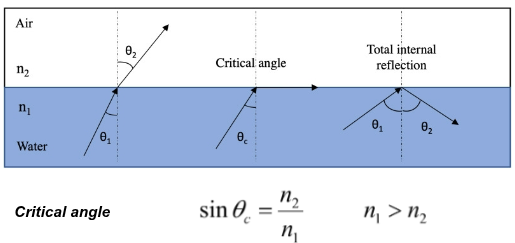
Dispersion
Dispersion is the process of separating polychromatic light into its component wavelengths
White light passed through a prism produces a visible spectrum through dispersion

Lenses
Formed by two curved boundaries between transparent media
Lenses often have spherical surfaces. The curved surfaces are parts of a large sphere(s) of radius r
Every lens shaped like a circle has a diametet, D, and a focal length, f
The focal point is determined by many factors including the curvature of the lens, the type and thickness of the medium used for the lens, etc.
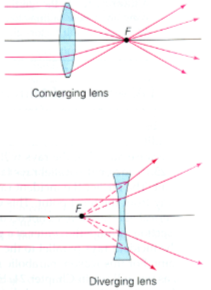
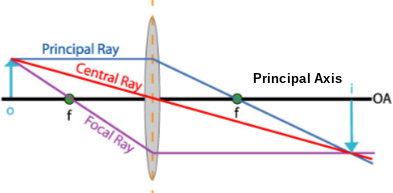
Use the acronym LOST to refer to the image!
L=location
O=orientation
S=size
T=image size
Real images form where light ways really meet
Virtual ones form where light rays only appear to meet
Real images can be projected onto a screen
Virtual images cannot be projected onto a screen
Real images usually appear upside down
Virtual images usually appear right side up
For lenses, real images lie behind the lens

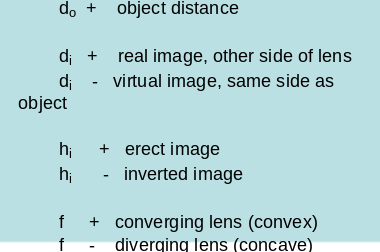

do is positive for objects to the left of the lens, negative for objects to the right of the lens (virtual objects)
di is positive for images to the right of the lens, negative for images to the left of the lens (virtual images)
f is positive for converging lenses, negative for diverging lenses

Mirrors
The Law of Reflection states the angle of incidence equals the angle of reflection
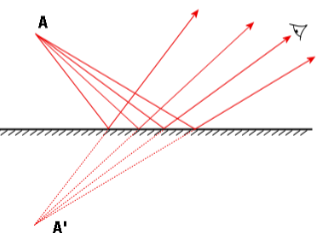


Flat (or plane) mirrors form virtual images that are the same distance from the mirror’s surface as the object is
The image formed by rays that appear to come from the image point behind the mirror—but never really do—is called a virtual image.
Real images form where the light rays really meet
Virtual images form where the light rays only appear to meet
Real images can be projected onto a screen
Virtual images cannot be projected onto a screen
Real images usually appear upside down
Virtual images usually appear right side up
For mirrors, real images form in front
For mirrors, real images form behind them
For lenses, real images lie behind the lens
For lenses, virtual images lie in front
A concave spherical mirror is a mirror which reflects light from it’s inner surface (caved in)
Concave mirrors can be used to form real images or virtual ones
A real image is an image formed when rays of light actually pass through a point on the image. Real images can be projected onto a screen
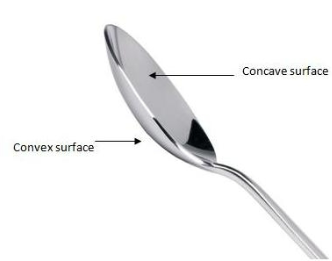
For the equations:
“c” stands for the center of the circle created by the curved mirror
“f” stands for the focal length of the mirror
(it’s different for each mirror and depends on its curvature)
(it’s halfway between the circle’s center and mirror)



When doing these calculations, we will refer to the LOST of the image
L = location (di)
O = orientation (hi)
hi > 0, it’s upright
hi < 0, it’s upside down
S = size (hi)
Absolute value of the hi
T = image type (di)
di > 0, it’s in front of the mirror and real
di < 0, it’s behind the mirror and the virtual

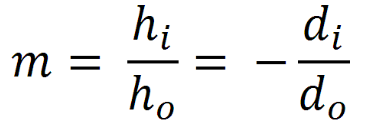
f = focal length
di = image distance
do = object distance
hi = image height
ho = object height
m = magnification
Ray diagrams can be used for checking values calculated from the mirror and magnification equations for concave spherical mirrors
Concave mirrors can produce both either real or virtual images